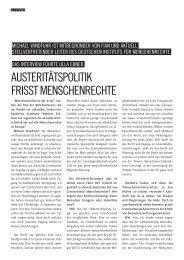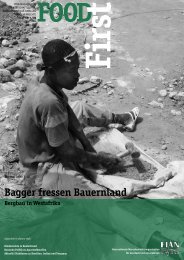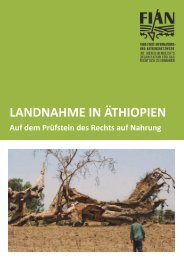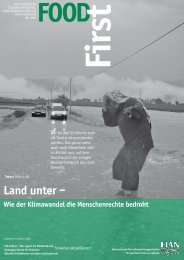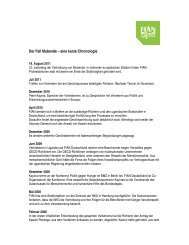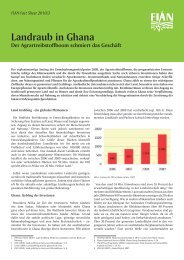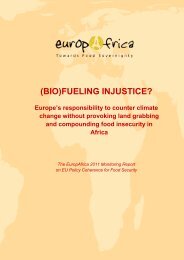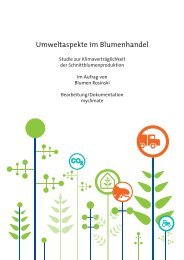Study 3: Ecodestruction and the Right to Food: The Cases of Water ...
Study 3: Ecodestruction and the Right to Food: The Cases of Water ...
Study 3: Ecodestruction and the Right to Food: The Cases of Water ...
Create successful ePaper yourself
Turn your PDF publications into a flip-book with our unique Google optimized e-Paper software.
Starving <strong>the</strong> Future <strong>Study</strong> 3<br />
vi. Alien species<br />
Species are “alien species” in an ecosystem if <strong>the</strong>y were introduced in<strong>to</strong> <strong>the</strong> ecosystem comparatively<br />
recently - usually by human intervention. Alien species are responsible for many recorded species<br />
extinctions, especially on isl<strong>and</strong>s. In <strong>the</strong>se isolated ecosystems, a new preda<strong>to</strong>r, competi<strong>to</strong>r, or<br />
pathogen can rapidly imperil species that did no co-evolve with <strong>the</strong> newcomer. In Hawaii for example,<br />
some 86 alien plant species seriously threaten native biodiversity; one <strong>of</strong> <strong>the</strong>m has now displaced more<br />
than 30.000 acres <strong>of</strong> native trees, resulting in large changes in ecosystem dynamics. One <strong>of</strong> <strong>the</strong> alien<br />
tree species has <strong>the</strong> ability <strong>to</strong> convert atmospheric nitrogen <strong>to</strong> ammonia just like peas <strong>and</strong> beans. This<br />
ability increases <strong>the</strong> nitrogen content <strong>of</strong> soils, <strong>and</strong> thus alters <strong>the</strong> raw materials on which many o<strong>the</strong>r<br />
plant species depend. Ano<strong>the</strong>r example for <strong>the</strong> adverse effect <strong>of</strong> alien species was <strong>the</strong> well-meant<br />
introduction <strong>of</strong> game fish <strong>to</strong> many lakes <strong>and</strong> streams throughout <strong>the</strong> world, resulting in <strong>the</strong> replacement<br />
<strong>of</strong> many native varieties.<br />
vii. Global climate change<br />
Human-caused increases in “greenhouse gases” (mostly CO2 from fossile fuels) in <strong>the</strong> atmosphere are<br />
likely <strong>to</strong> commit <strong>the</strong> planet <strong>to</strong> a global temperature rise <strong>of</strong> some 1 <strong>to</strong> 3 degrees Celsius during <strong>the</strong><br />
century, with an associated rise in sea level <strong>of</strong> 1 <strong>to</strong> 2 meters. With this global warming some species will<br />
find less optimal habitat than before, particularly in higher latitudes. Plants <strong>and</strong> animals that now inhabit<br />
montane <strong>and</strong> alpine habitats - <strong>and</strong> which are <strong>the</strong>re through an evolved dependence on cooler<br />
temperatures <strong>and</strong> higher altitudes - may with warming <strong>of</strong> <strong>the</strong>se regions have nowhere else <strong>to</strong> go. Each<br />
1°C rise in temperature will displace <strong>the</strong> limits <strong>of</strong> <strong>to</strong>lerance <strong>of</strong> l<strong>and</strong> species some 125 kilometers <strong>to</strong>ward<br />
<strong>the</strong> poles, or 150 meters vertically on <strong>the</strong> mountains. Many species will not be able <strong>to</strong> redistribute<br />
<strong>the</strong>mselves fast enough <strong>to</strong> keep up with <strong>the</strong> projected changes, <strong>and</strong> considerable alterations in<br />
ecosystem structure <strong>and</strong> function are likely.<br />
Ecologically <strong>and</strong> socially acceptable management <strong>of</strong> biodiversity is a prerequisite for <strong>the</strong> preservation <strong>of</strong><br />
<strong>the</strong> wealth <strong>and</strong> productivity <strong>of</strong> natural ecological systems. <strong>The</strong> Agenda 21 adopted at <strong>the</strong> UNCED in Rio<br />
in 1992 calls for concerted action by governments, governmental <strong>and</strong> non-governmental organizations,<br />
<strong>and</strong> <strong>the</strong> scientific community for <strong>the</strong> preservation <strong>of</strong> biodiversity.<br />
References:<br />
• Dobson A., Campbell M.S., Bell J., Fatal synergisms: interactions between infectious diseases, human<br />
population growth, <strong>and</strong> loss <strong>of</strong> biodiversity.<br />
• Grifo F., Rosenthal J., edi<strong>to</strong>rs (1997). Biodiversity <strong>and</strong> human health. Washing<strong>to</strong>n, DC: Isl<strong>and</strong> Press, 1997:<br />
87-110.<br />
• Daily G., Ehrlich P. (1992). Population, sustainability, <strong>and</strong> Earth's carrying capacity. Bioscience, 42, 761-771.<br />
• Daily G. et al. Ecosystem services: Benefits supplied <strong>to</strong> human society by natural ecosystems:<br />
http://esa.sdsc.edu/daily.html<br />
• Hughes J. B., Daily G. C., Ehrlich P. R. (1997). Science 278, 689.<br />
• Farnsworth N. R., Akerele O., Bingel A. S., Soejar<strong>to</strong> D. D., Guo Z. (1985). Medicinal Plants in <strong>The</strong>rapy.<br />
Bulletin <strong>of</strong> <strong>the</strong> World Health Organization, 63(6): 965-981<br />
• Law<strong>to</strong>n <strong>and</strong> May (1995): http://essp.csumb.edu/esse/ecoservintro/ecoservthreats.html<br />
• Wilson E.O. (1989). Threats <strong>to</strong> biodiversity. Scientific American 261: 108-16.<br />
• C. Pearl, 54-69. New York: Oxford University Press.<br />
• FAO, <strong>Food</strong> For All (1996)<br />
• FAO: www.fao.org/biodiversity/index.asp<br />
• Tuxill J. (1999). Nature’s Cornucopia: Our stake in plant diverstiy, WorldWatch Paper 148.<br />
• Biodiversity <strong>and</strong> protected areas, World Resources Institute: www.wri.org/biodiv/bri-why.html<br />
• New Biodiversity Assessment, World Resources Institute: www.igc.org/wri/wr-96-97/bi_txt2.html<br />
• Global Biodiversity Assessment, Policymaker’s summary, United Nation Environment Programme (UNEP,<br />
1996): www.unep.org<br />
• Loss <strong>of</strong> biodiverstiy: www.earthgreen.org/biodiversity.htm<br />
FIAN International 112<br />
June 2002



